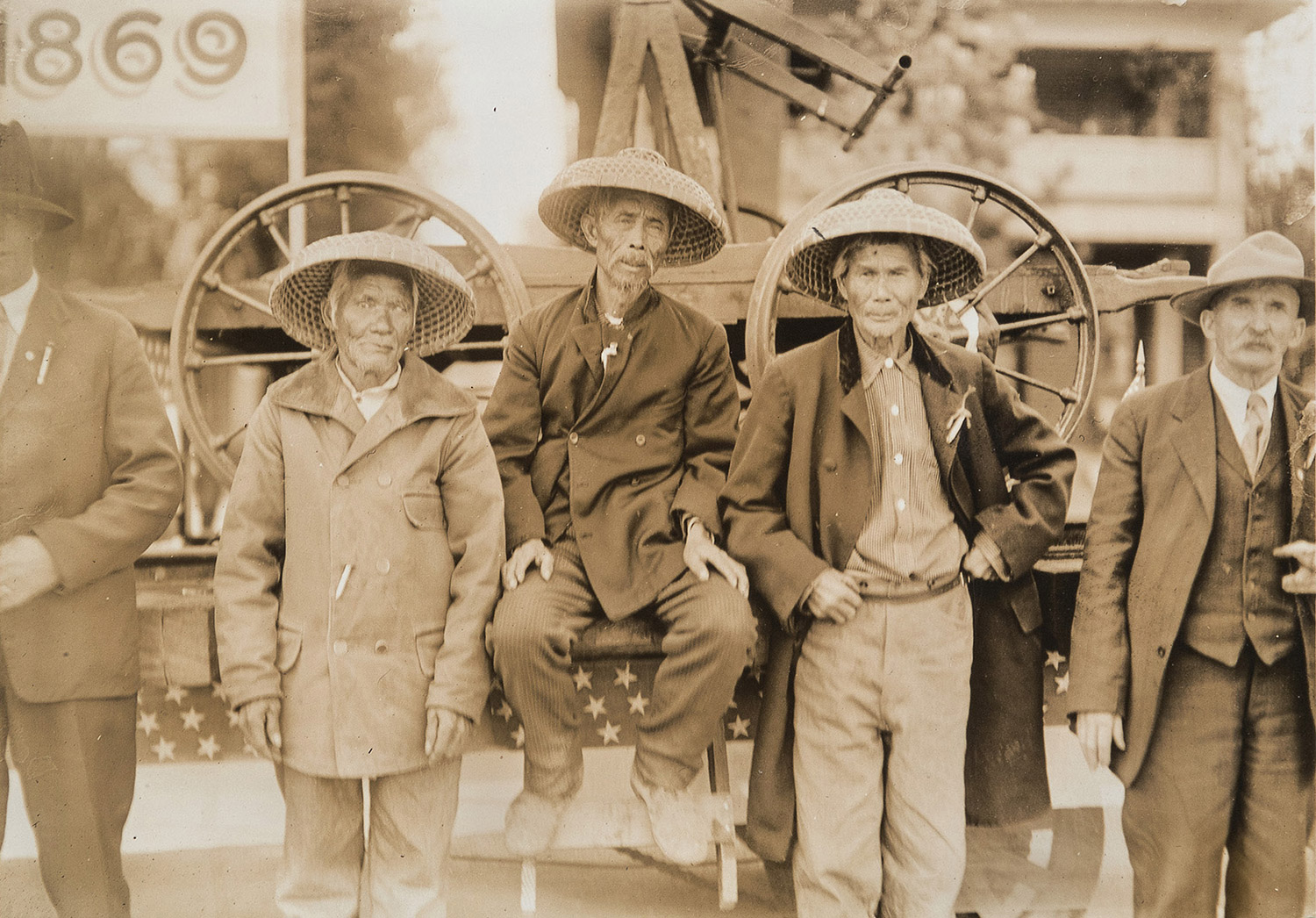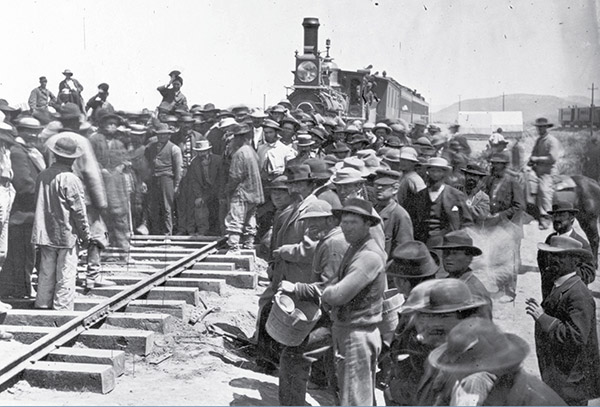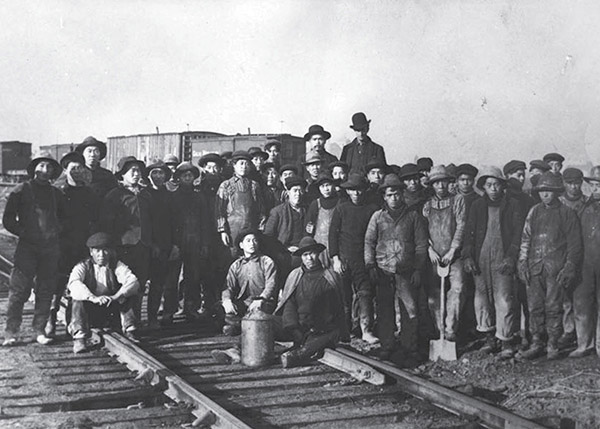Geisel Library Exhibit Sheds Light on Chinese Workers Who Built Transcontinental Railway
Published Date
By:
- Dolores Davies
Share This:
Article Content

Ging Cui, Wong Fook, and Lee Shao, three of the eight Chinese workers who put the last rail in place, on a float at the 50th Anniversary celebration of the completion of the transcontinental railroad in Ogden, Utah. Photo by courtesy of Amon Carter Museum of American Art Archives, Fort Worth, TX
The Chinese and the Iron Road: Building the Transcontinental, produced by the Chinese Historical Society of America and the Chinese Railroad Workers Project at Stanford University, is on display through February 29, 2016 in Geisel Library on the University of California, San Diego campus. The exhibit tells the undocumented story of thousands of Chinese migrants, who played an instrumental role in the construction of the nation’s first transcontinental railway in the 1860s.
In addition to the partnership with the Chinese Historical Society of America and the Chinese Railroad Workers Project at Stanford, the Chinese American Library Association’s Task Force on Chinese Railroad Workers, which seeks to increase awareness and appreciation for the contributions of Chinese Americans, helped to bring the exhibit to the campus.
A reception will be held on Friday, January 22, from 3 to 5 p.m. in the Seuss Room in Geisel Library, to celebrate the opening of the exhibit at the UC San Diego Library, the first institution to host the exhibit after its debut last summer at Stanford University and the Chinese Historical Society of America. The reception will include remarks from: Hilton Obenzinger, associate director of the Chinese Railroad Workers Project and a Lecturer in American Studies & English at Stanford University; Simeon Man, a scholar of Asian American Studies and an assistant professor in UC San Diego’s Department of History; and Murray Lee, Curator of Chinese American History for the San Diego Chinese Historical Museum. The event is free and open to the public. To make a reservation, please click here.

Chinese laying the last rail on May 10, 1869. Photo taken by Andrew J. Russell (1830-1902), a photographer assigned to document construction of the first transcontinental railroad as it stretched westward across the continent in the late 1860s. Photo by courtesy of the Kyle Watt Collection
“We are thrilled to be able to collaborate with colleagues at the Chinese Historical Society of America, Stanford University, and the Chinese American Library Association, in presenting this highly informative exhibit to the campus and local communities,” said Brian E.C. Schottlaender, The Audrey Geisel University Librarian at UC San Diego. “Increasing public awareness and appreciation for the amazing contributions made by Chinese Americans in the building of our country’s first transcontinental railway is critical to understanding this important part of our history, and we are proud to be part of this.”
The exhibit traces the laborious and often perilous four-year construction—from 1865 to 1869— of the U.S.’s first major east-west railroad, beginning with the bill signed by President Lincoln authorizing the undertaking. Approximately 12,000 Chinese laborers toiled at a grueling pace, and in extremely dangerous working conditions to help construct the railroad, which was actually two railways meeting in the middle—the Central Pacific from Sacramento, California to the east and Union Pacific from Omaha, Nebraska to the west.
The east railway was not nearly as challenging as the west, which was built mostly by Chinese workers, which required building tunnels through the Sierra Nevada Mountain range, with its long stretches of granite. The Chinese not only endured blasting through granite and grading roadbeds, but there were also dangerous avalanches, frequent snow drifts, illnesses and accidents, as well as Indian raids to contend with. The exhibit also sheds light on the cruel sinophobia and racism that the Chinese workers suffered. Unfair wages and other discriminatory practices were prevalent at the time, as were anti-Chinese protests and more violent acts.

Chinese work group for the Great Northern Railway, c. 1909. Photo by courtesy of Royal British Columbia Museum
At the beginning of the long endeavor when workers were being recruited by both railroads (the Central Pacific and Union Pacific), the majority of workers were of European descent—mostly Irish. But, a dearth of Caucasian workers led one of the railroad owners, Charles Crocker, to suggest they look to the Chinese migrant population for more laborers. While his suggestion was met with skepticism by many, it proved to be a linchpin in the successful completion of the railroad.
The Chinese and the Iron Road: Building the Transcontinental exhibit is part of the Chinese Historical Society of America Museum’s Work of Giants: Chinese Railroad Worker Project. This initiative was launched in 2014 on the 145th anniversary of the completion of the nation’s first transcontinental railroad. The CHSA is continuing to collaborate with the Chinese Railroad Workers in North America Project at Stanford University (CRRW), which seeks to identifying descendants of railroad worker families to honor the memory and legacy of their pioneer forefathers. By sharing the stories of the descendants of known Chinese railroad workers who helped to build the American West, the initiative hopes to increase awareness and appreciation for the significant role the workers played in completing a monumental and life-changing project. For more information about the initiative, please click here.
Share This:
You May Also Like
$10 Million Grant from Price Philanthropies Launches Behavioral Health Hub at UC San Diego Health
Health & BehaviorStay in the Know
Keep up with all the latest from UC San Diego. Subscribe to the newsletter today.



